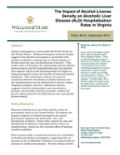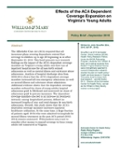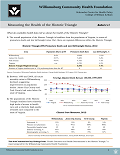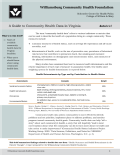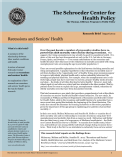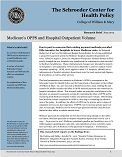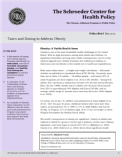Policy and Statistical Briefs
Schroeder Center policy and statistical briefs provide an in-depth look at health-related policies and research on health and healthcare.
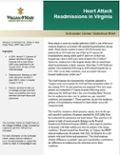 |
Heart Attack Readmissions in Virginia |
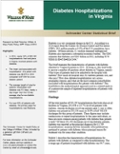 |
Diabetes Hospitalizations in Virginia |
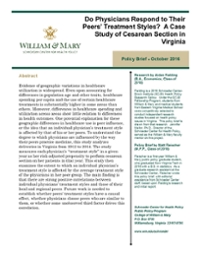 |
Do Physicians Respond to Their Peers' Treatment Styles? A Case Study of Cesarean Section in Virginia |
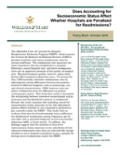 |
Does Accounting for Socioeconomic Status Affect Whether Hospitals are Penalized for Readmissions? |
|
|
This brief summarizes a study that describes the relationship between alcohol license density and the hospitalization rate for alcoholic liver disease (ALD) in the Commonwealth of Virginia to help policymakers assess the benefits of increased alcohol regulation. This brief presents evidence of a positive association between the density of alcohol licenses and the hospitalization rate for alcoholic liver disease within Virginia’s localities; however, the brief provides additional evidence that suggests this relationship is not causal and is, perhaps, attributable instead to multiple, unobserved factors influencing both the ALD disease rate and alcohol license density. |
|
|
Effects of the ACA Dependent Coverage Expansion on Virginia's Young Adults This brief presents new research findings on the impact of the Affordable Care Act's (ACA’s) dependent coverage mandate on Virginia’s young adults and their use of inpatient hospital care for all non-birth related admissions as well as mental illness and substance abuse admissions. Analysis of hospital discharge data from 2008-2014 shows that the ACA’s dependent coverage mandate increased all non-emergency admissions as well as mental illness and substance abuse admissions. Additional evidence shows that the dependent coverage mandate reduced the share of young adults hospital admissions paid by Medicaid and increased the share of admissions paid by private insurance. The dependent coverage mandate also led to an increase in treatment intensity among hospitalized persons, defined as increased lengths of stay and total charges for non-birth admissions. |
|
Measuring the Health of the Historic Triangle This brief summarizes what available health data can tell us about the health of the Historic Triangle of Virginia, a community consisting of James City County, York County, and the City of Williamsburg. Findings summarized in this brief are from “Health Outcomes and Health Determinants in the Historic Triangle,” a report that inventories and reviews existing data on health outcomes and health factors for the Historic Triangle. A Guide to Community Health Data in Virginia can be used as a supplement to this brief. Read the full report. This brief was prepared by Jennifer M. Mellor (Ph.D.) and Elizabeth Vestal (J.D., M.P.P.) and funded by a generous grant from the Williamsburg Health Foundation. |
|
|
A Guide to Community Health Data in Virginia The term “community health data” refers to various indicators or metrics that can be used to describe the health of a population living in a single community. These measures include summary measures of health status, such as average life expectancy and all-cause mortality, and determinants of health, such as the use of preventive care and the prevalence of behavioral risk factors that contribute to premature death. In this brief, you will find types of available community health data for Virginia localities and what users should know about using these community health data. This brief was prepared by Jennifer M. Mellor (Ph.D.) and Elizabeth Vestal (J.D., M.P.P.) and funded by a generous grant from the Williamsburg Health Foundation. |
|
|
|
Recessions and Seniors' Health This brief summarizes a study that provides a comprehensive look at the effects of recessions on seniors’ health and health-related behaviors. The study, by economists at William & Mary’s Department of Economics and Schroeder Center for Health Policy, adds to the recessions and health literature by using data from a more recent time period that includes the beginning of the Great Recession. This study also extends the literature by focusing exclusively on the senior population given the importance of this age group in explaining prior patterns of procyclical mortality. |
|
Medicare’s OPPS and Hospital Outpatient Volume Effective August 1, 2000, the Outpatient Prospective Payment System (OPPS) greatly changed the way hospitals were reimbursed for outpatient services provided to Medicare beneficiaries. This brief summarizes research on Medicare’s OPPS by economists at William & Mary's Department of Economics and Schroeder Center for Health Policy. In a 2012 Journal of Health Economics article, Daifeng He and Jennifer M. Mellor examine the effect of OPPS-induced payment rate reductions on hospital outpatient volume. |
|
|
Taxes and Zoning to Address Obesity The increasing percentage of overweight and obese Americans threatens the health of millions and significantly contributes to rising healthcare costs in the U.S. Policymakers continue to search for solutions to this health problem. Most recently, New York City Mayor made headlines by calling for a ban on the sale of large servings of soda. This policy brief, by Elizabeth Vestal (J.D., M.P.P.), is a discussion of taxing and zoning options, focusing specifically on soda taxes, restrictive fast-food restaurant zoning, and healthy food enterprise initiatives as obesity prevention policy options. |
|














